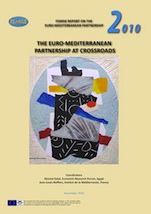 FEMISE has released its latest report on the Euromediterranean Partnership and the situation of the Mediterranean countries. The subject of this year’s report is focused on the factors circulation and human mobility.
FEMISE has released its latest report on the Euromediterranean Partnership and the situation of the Mediterranean countries. The subject of this year’s report is focused on the factors circulation and human mobility.
To address these issues, this first part of the report is organized in 4 main chapters: (i) The first chapter aims to determine the effect and the remaining potential of the free trade area that was to be established in the framework of Barcelona process; (ii) The second chapter details the state of the capital flow mobility in the region, as well as its impact, especially in terms of volatility; (iii) The third chapter is devoted to give an overview of the current level of labour mobility in the Euromed region and some reflexion on the possibility of enhancing potential benefits; (iv) the fourth chapter proposes an overview of the human development in the Euromed region, with emphasis on the poverty and the level and determinants of inequalities.
In the second part, the report addresses the current situation of the south Mediterranean economies concerned, country by country.
Download the English version of the Report (271 pages – 4,8 Mo)
The Euro-Mediterranean Partnership at Crossroads
Table of Contents
Introduction
Part one
Chapter 1. Impact of the Euro-Mediterranean Partnership 15 Years after Barcelona: What Do we Know ? What Can be done?
I. Main characteristics of the EU-MPs trade patterns since 1995
II. Quantitative assessments of the Euromed agreements : a survey and critical analysis
Chapter 2. Capital Flows In The Euro-Med Region
I. Introduction
II.Trends in Capital Flows in the MPs: 2004-2009
III. Capital Flows Impact, Volatility, and Contribution to Investment and Debt
IV. Policy Recommendations
Chapter 3. Mobility of Labour in the EU-Med: Potentials vs Constraints?
Introduction
I. Mobility across the Mediterranean: Labour and Remittances
II. Impediments to a beneficiary migration process in the EU-Med region
III.Achieving the Potential benefits of Migration in the EU-Med: How?
Chapter 4: Review of poverty in the MPCs
I. Survey of poverty and human development in the Mediterranean region
II. Link between growth, inequalities and poverty in the region
III. The determining factors of inequalities in Mediterranean countries:
study of the role of sources of income, employment and commercial opening
IV. Conclusion
References
Part two – Detailed situation in MPs : country sheets
Algeria
Egypte
Israel
Jordan
Lebanon
Morocco
Syria
Tunisia
Turkey
Annexes


